One of the best parts of playing Magic is when you know something that other people don’t and you can use that knowledge to gain an edge. One of the worst parts of Magic is when you’re wrong about your perceived edge and it blows up horribly in your face.
Despite a lot of initial hype, the general sentiment right now seems to be that Collected Company is a bust in Modern. A lot of high-level players and writers have written it off as not being very good. I politely disagree. Either I know something that other people don’t, or I’m horribly wrong and am going to reap my just rewards. The Season Two Invitational this weekend is where I’m going to find out just how right or wrong I am.

I’ve logged hundreds and hundreds of matches with Collected Company over the past few weeks. The decklist I’m playing now is a far cry from the list I started with, and even quite a bit different than a lot of the lists I’ve worked on in between. I’m not a natural talent in that I can’t just envision a deck and know exactly how it needs to be built. For me it takes trial and error, and I’ve had my fair share of both.
At this point, however, I feel like the deck is right where I want it to be. When I first started battling with the deck, I was losing a lot, but now I’m gaining lots of confidence with it and feel good about my matchup against most decks. I’m also learning a lot about the various lines of play you can take and how you’re supposed to play the deck in the wide variety of matchups you can run into in Modern.
My win percentage has increased a lot as I became more and more familiar with the deck and the more and more I tuned the list. Let’s start with the current list.
Creatures (30)
- 4 Birds of Paradise
- 3 Eternal Witness
- 2 Wall of Roots
- 1 Reveillark
- 4 Kitchen Finks
- 1 Murderous Redcap
- 3 Noble Hierarch
- 1 Linvala, Keeper of Silence
- 3 Viscera Seer
- 1 Spellskite
- 2 Melira, Sylvok Outcast
- 2 Scavenging Ooze
- 1 Fiend Hunter
- 2 Anafenza, Kin-Tree Spirit
Lands (22)
Spells (8)

Thanks to a whopping nine mana-producing creatures, I feel comfortable playing only 22 land. Moreover, I’m even playing two copies of Horizon Canopy to smooth draws by offering a way to combat flooding out. The drawback to Horizon Canopy is mitigated a lot by cards like Scavenging Ooze and Kitchen Finks which can gain a lot of life over the course of a game.
Ever since I swapped to 22 land and two Canopies, I started to instantly notice an improvement in wins. Games where you brick on a Collected Company and lose by flooding out became rarer and rarer with access to four lands (two Horizon Canopy and two Gavony Township) that give you the ability to still do things with land-heavy draws.
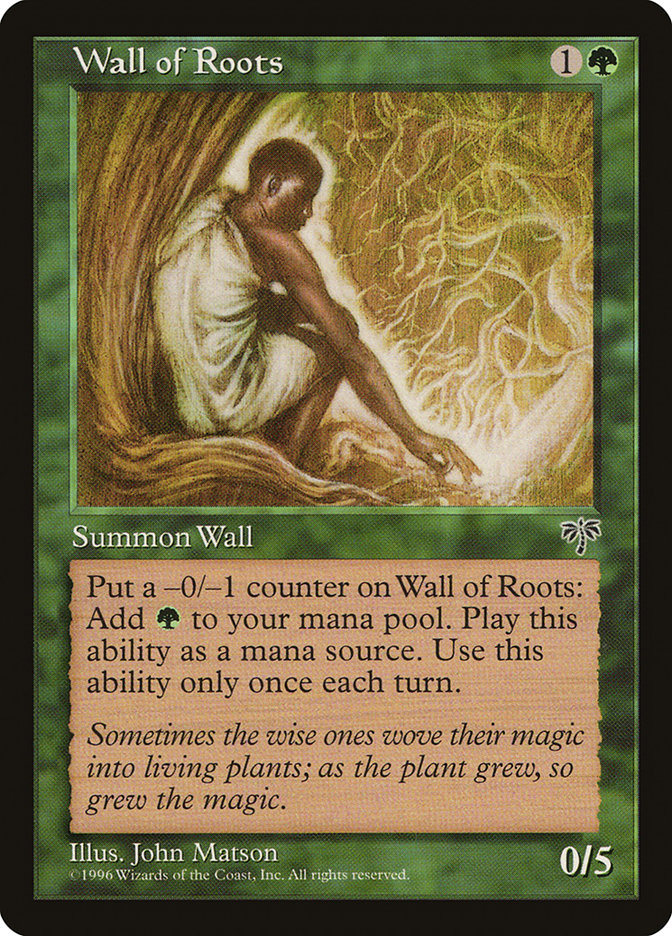 Playing Wall of Roots in addition to Noble Hierarch and Birds of Paradise allows for the deck to play the full four copies of Chord of Calling, something it wants to do anyway. Basically, I wouldn’t want to play Wall of Roots without Chord of Calling to use with it, and I wouldn’t want to play a full set of Chords without Wall of Roots to actually make them castable.
Playing Wall of Roots in addition to Noble Hierarch and Birds of Paradise allows for the deck to play the full four copies of Chord of Calling, something it wants to do anyway. Basically, I wouldn’t want to play Wall of Roots without Chord of Calling to use with it, and I wouldn’t want to play a full set of Chords without Wall of Roots to actually make them castable.
Wall of Roots generates an absurd amount of mana. It’s hard to understand without playing with the card yourself, but the ability to produce mana on both your turn and your opponent’s turn is not to be underestimated. A turn-two Wall of Roots allows for a turn-three Birds of Paradise and Collected Company, or Birds of Paradise and Chord of Calling for three on your opponent’s turn. It’s also great with cards like Scavenging Ooze to allow you to turbo through graveyards to grow the Ooze or shrink Tarmogoyfs.
That’s not even mentioning how good Wall of Roots is at blocking. Suck it Tasigur, Siege Rhino, and Tarmogoyf. Wall of Roots is on duty.
This deck is very simplistic. It’s just 22 land, eight creature-finding spells, and thirty creatures. Gone are Path to Exile, Abrupt Decay, or other removal spells – at least from the maindeck. While it may seem very difficult to win games without cards like that, it’s actually easier than you think. Fiend Hunter serves as a tutorable answer to a number of threats, and Linvala can shut out hate cards like Scavenging Ooze.
Playing this high of a density of creatures makes both Chord of Calling and Collected Company better. It also improves the value of Gavony Township, and it makes being able to just grind or value your opponent out of the game a reasonable option – especially with a card like Reveillark. The combo between Reveillark and Eternal Witness is pretty hard to overcome. You can just evoke Reveillark to get back a few Eternal Witnesses to rebuy Reveillark and some other card, and then just play the Reveillark again when your Eternal Witnesses die to start the chain again.
But that’s enough about the composition of the deck. The main question is “why should I even bother to play this?”
Why Play Collected Company?
The first answer is that it is proactive. It is important to be proactive in Modern and be able to potentially just kill your opponent out of nowhere or present threats that can end the game fast enough, like Tarmogoyf. I personally think that Jeskai Control is one of the worst possible decks in Modern you can play. The reason for that it because the deck has no ability to be proactive and is going to lose a lot of matches simply due to that. There are a lot of decks that you can’t beat by being reactive, like Tron. Playing a deck like Jeskai gives you no way out when your opponent shows up with a strategy that your spells don’t interact with profitably.
Collected Company doesn’t suffer from that. It has a number of ways to assemble infinite life, infinite damage, or infinitely large creatures that can simply end games on the spot. Even if you can’t assemble a combo, it can still win a game by just beating down. A lot of the creatures are pretty mediocre at attacking, but thanks to Exalted and Gavony Township sometimes it’s still fast enough to get the job done anyway.
The second reason is that it is adaptable and hard to play around. There are creatures that are capable of doing pretty much everything you want in Modern. You can tailor the deck to fit any metagame, and having access to silver bullets and ways to find them like Chord of Calling can give you a lot of free wins. Get paired against Elves? How about a Chord of Calling for Linvala. Nice deck! Affinity big in your metagame? How does Kataki taste? Young Pyromancer got you down? Let me Orzhov Pontificate on how to attack that one. I’m thinking some neg-one neg-one action, but that’s just me.
Furthermore, the deck is very good at grinding opponents out. Eternal Witness to rebuy Collected Company and Chord of Calling is great value. The inherent two-for-one nature of Persist is also good value, especially with access to cards like Anafenza, Kin-Tree Spirit or Gavony Township to reset counters. If your opponent’s path to winning is to just kill everything, it’s going to be very hard for them to succeed.
Lastly, Collected Company has a fantastic matchup against random decks. There are so many fringe decks like Living End, G/W Hexproof, Soul Sisters, Dredgevine, and many more in the Modern format, and people love to play them. Most of these highly linear strategies with little removal are simply bad against a fast infinite-life combo. Due to the volatile nature of the format, it’s important to take as many free wins as you can get. Even if you don’t expect to ever get paired against any of these random strategies, it’s nice to know that you have a good matchup if you do.
Why Play This List?
I firmly believe that to be successful playing Collected Company, it’s important to be playing the combo versions of the deck. Other versions are simply too fair in an unfair format. If you are trying to play fair in Modern, to succeed you need to have access to loads of hand disruption, or a fast clock and cheap countermagic. The problem is that Collected Company demands that you play enough creatures to utilize it, rendering too many Thoughtseize-style effects worthless, and it isn’t an aggressive-enough card to close out games quickly by itself. It’s great in grindy matchups, but then again, so is Dark Confidant, a card that comes down a few turns earlier and can actually generate more advantage than Collected Company very quickly.
When you’re playing a combo deck, however, Company lets you dig really deep to find missing pieces. It no longer becomes a slow source of value, it becomes instead an instant-speed way to assemble a combo. It also can still play a grindy value game if needed, but that’s not the primary plan, and having versatility is very important.
I like this list the most because it has no frills. It’s simply chock-full of combo pieces, support, and ways to find those cards. It doesn’t have a bunch of random stuff, and it doesn’t need to.
How Do You Play The Deck?
Generally speaking, your goal with the deck should be trying to figure out how to combo as early as possible, but barring that, or finding yourself in a matchup where that isn’t feasible, the game-plan becomes about finding alternative routes to victory. This often involves grinding them out with cards like Gavony Township or repeating Collected Company over and over again.
One of the consistently used lines of play this deck can take to generate a small bit of value is to Chord for three and get an Eternal Witness to return Chord to your hand. In an attrition matchup, like against Abzan or Jund, this simply provides a free 2/1 creature at no loss of a card, just mana. That might not seem like much, but with cards like Gavony Township in the mix and with more creatures reducing the cost of Chord of Calling, it adds up.
Chording for Eternal Witness a few turns in a row also sets up a later Chord for 5 to find a Reveillark, which can quickly shut the door on decks trying to grind you out. They must answer the Reveillark or die to a 4-power flying creature, but in doing so they get wrecked by those Eternal Witnesses coming back onto the battlefield and generating a huge amount of value. This plan doesn’t work when you’re getting destroyed by Scavenging Ooze. Those are the situations where you have to hope a card like Linvala or Fiend Hunter is going to be good enough to keep the Scooze at bay.
One of the hardest aspects of playing the deck is learning how to play around sweepers. There are a lot of situations where you have to measure your resources and gauge how many creatures it will take on the board so that you’re pressuring your opponent enough, but without opening yourself up to get destroyed by a Pyroclasm, Anger of the Gods, or Jund Charm.
To go along with that, Collected Company offers some interesting challenges in terms of when to cast it. The preferred time is to just cast it as soon as possible on your turn. That gives you the most information on how you should attack or block or play out the rest of the turn. It also can find creatures like Noble Hierarch to push in extra damage from attacks. That breaks down, of course, when your opponent is going to have interaction.
If you think your opponent has a sweeper, then you should cast Company on their end of turn step. If you already have enough pressure in play to force them to cast the sweeper without Company involved, then you don’t even want to cast it at all. If you think they might have countermagic but you’re unsure, then I tend to prefer to cast the card in their upkeep. This forces them to use their counter before they have a chance to draw, which is important to prevent them from drawing one if they don’t have one or getting an extra card they can use to make their decision on whether or not to counter it.
If you’re certain they have a counter, then there are a few ways to play it. One is to cast Collected Company at any time they tap out, no matter what phase it is. If they tap out on your end of turn to cast a Vendilion Clique, you can slam down Company (and probably hit five lands and a Birds of Paradise, but you know, gotta at least try). Another option if your hand is loaded with gas is to cast Company during their end step, and then untap and cast another when they’re tapped out from countering the first.
If you’re certain that they have a counter and you don’t have a lot of gas in hand, and they are constantly holding open mana to pay for the counter, then I usually like to just play a waiting game. Eventually you will start to draw some gas or something else they have to counter. Also, a lot of counters in Modern are cards like Mana Leak that lose power as the game continues. In games like this, they aren’t only constricting you by holding open countermagic, they are actually constricting themselves as well. The worst thing to do is let them counter your only good card and then give them the freedom to tap out the rest of the turns once they’ve cast their piece of countermagic.
One final tip is that if you’re holding open mana to cast Collected Company and your opponent casts something like Scavenging Ooze, it’s important to Company in response to the Ooze being cast. If you hit Eternal Witness, Scavenging Ooze can eat the card you target out of the graveyard first. Also, you might assemble a combo with Kitchen Finks and Viscera Seer along with Anafenza or Melira, and Scavenging Ooze also interrupts that combo by eating Kitchen Finks with the Persist trigger on the stack. Lastly, you might hit your own Scavenging Ooze and get to use it a few times before theirs enters the battlefield to Ooze value.
Sideboarding
I’m not going to provide an in-depth sideboarding guide because, well, Modern is such an enormous format and there are way too many decks to address. I could go fifteen decks deep and still be missing archetypes that people play reasonably often.
Instead, I’m going to talk about each card in the sideboard and when you’re going to want to bring it in, and I’m going to provide some cards in the maindeck that are typically what you side out.

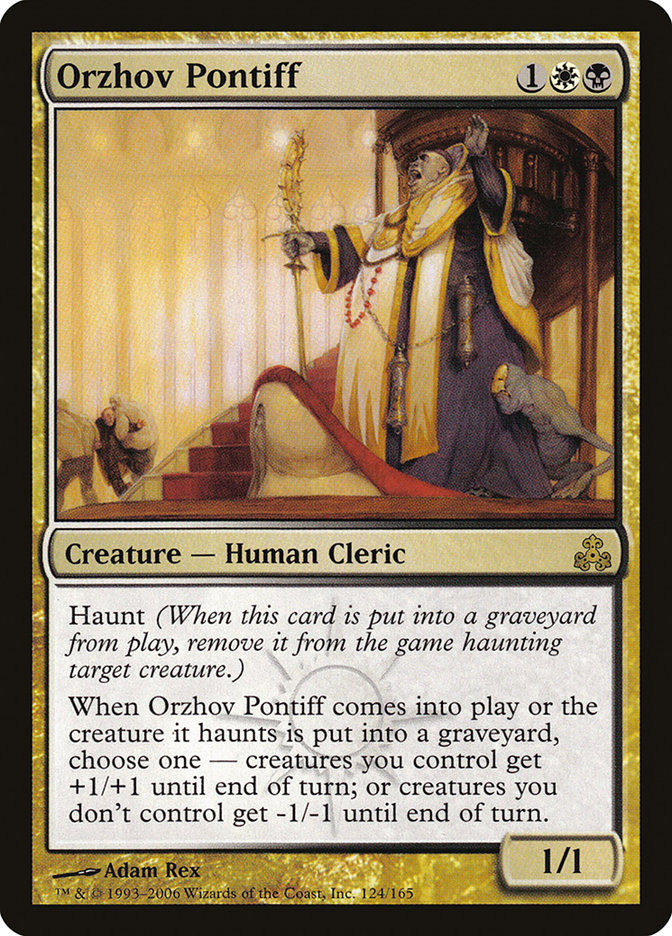
A lot of the cards are self-explanatory. Qasali Pridemage, for example, is going to come in to combat artifacts and enchantments. Orzhov Pontiff comes in to fight X/1 creatures, which includes decks like Jund and Abzan to kill Grim Lavamancer, Dark Confidant, and Lingering Souls.
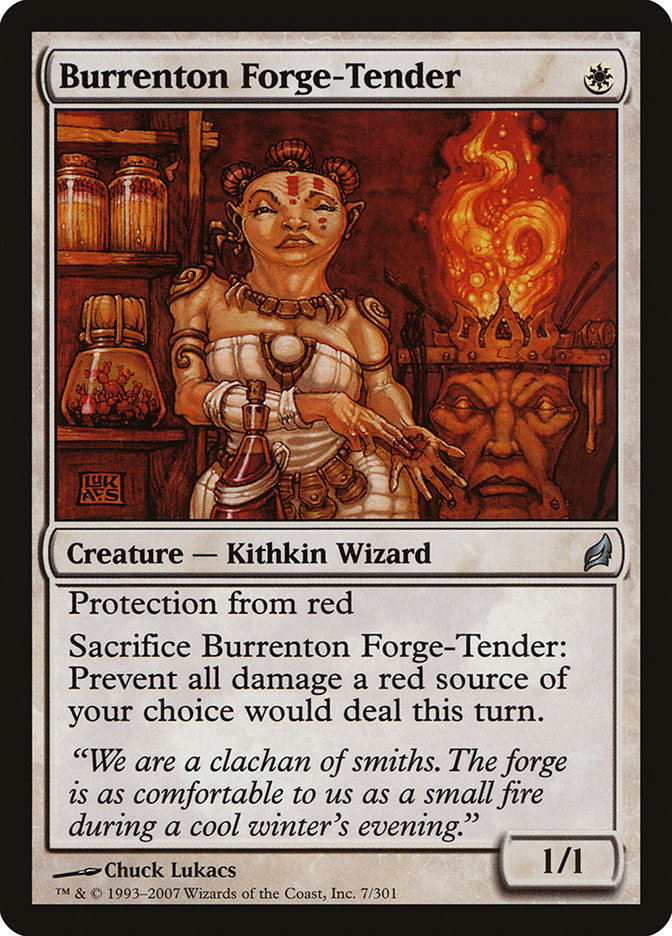
Burrenton Forge-Tender’s main purpose is to counter Pyroclasm, Anger of the Gods, Jund Charm, or any other red sweeper that you might run into. It’s also good against Burn. It blocks their creatures and can gain 3-4 life at some point in the game. Just don’t try to use it against Skullcrack.

Path to Exile only really comes in for grindy matchups or matchups where you absolutely have to have it. I’d side in Path vs. Elesh Norn, but I’m not going to bring in Path to Exile against something like G/R Tron to fight Wurmcoil Engine. That’s generally a losing battle and having these slow, reactive cards makes it hard to beat them. I’d rather rely solely on Chord for Fiend Hunter if I need an answer to Wurmcoil Engine and have the rest of my deck be super-proactive otherwise.
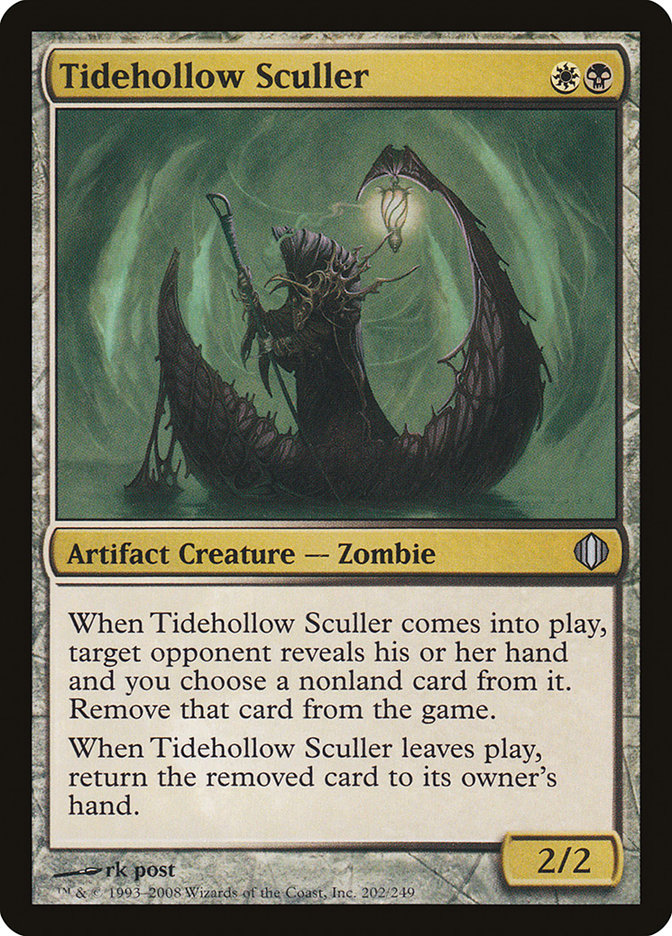
Tidehollow Sculler only comes in against combo decks. It’s a mediocre threat in fair matchups and can further put you in a hole against cards like Kolaghan’s Command or Anger of the Gods. It’s pretty important in combo matchups, however, because you have to have some level of disruption against decks that are faster. I don’t side these in against Twin and rely on Abrupt Decay and cards like Spellskite and Linvala to keep them off the combo.
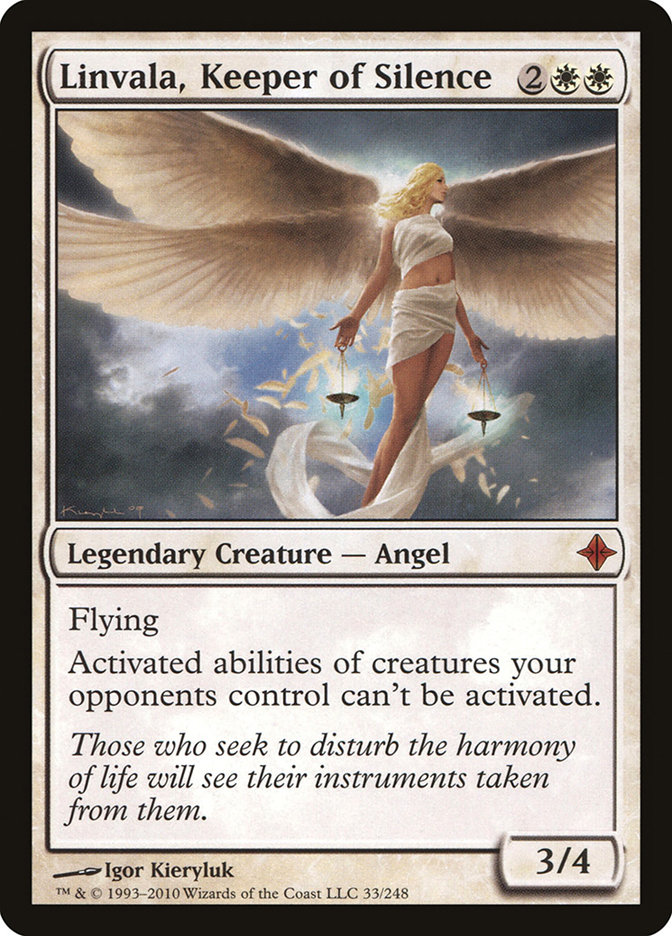
Linvala is good against almost every single deck in the format, which is why I have one maindeck and one sideboard. It’s good against Jund and Abzan, shutting off Scooze, Grim Lavamancer, Olivia, and friends. It’s also a four- toughness flying creature that can’t be Abrupt Decayed. It’s good against Twin and it singlehandedly shuts down nearly every single creature in the mirror or against Elf Company. It’s also great vs. Affinity because it blocks their flying creatures and stops Arcbound Ravager and Steel Overseer from doing anything.
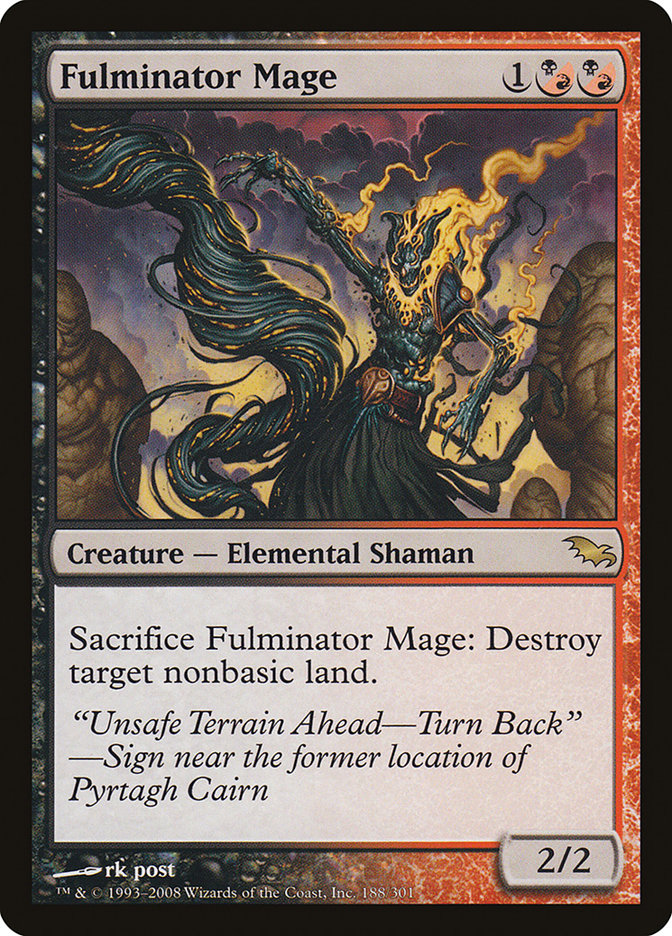
Fulminator Mage feels like a necessity in this format. If I wasn’t trying to combo people, I would have four of these in my maindeck. It is so good against so many decks, but it’s mainly for Tron and Amulet Bloom, two archetypes that are really hard to beat. It’s also extremely difficult for Jeskai Control to beat this card, especially with Eternal Witness potentially bringing it back for more. I love that you can find these off of Collected Company. You haven’t lived until you’ve cast Collected Company into double Stone Rain.
In matchups where my opponent has a ton of removal, I tend to side out all or nearly all of the combo and focus on grinding them out with Eternal Witness and Collected Company and Reveillark.
In matchups where the games are going to be really fast, I tend to side out things like Reveillark and Eternal Witness as they are too slow to compete. Linvala, as well, unless they are relying on creature abilities. I also trim on Witness and Reveillark against heavy graveyard hate, like Leyline of the Void, Rest in Peace, or something like Tron where they have four copies of Relic of Progenitus.
Scavenging Ooze comes out when there aren’t going to be a lot of creatures hitting the bin, such as against Amulet Bloom. Spellskite gets the axe in grindy fair matchups or against decks where his effect is pretty meaningless.
In matchups like Jund, Abzan, and Jeskai where they are trying to kill everything, I tend to side out one or two mana creatures so that I don’t flood on them and just to improve my threat density some. I also bring in Path and Abrupt Decay, so it’s less important to jump out to a blistering start.
I rarely cut any Collected Company or Chord of Calling, but it is reasonable to believe that there exist matchups where I want to do this.
The most important thing to do when sideboarding is try to understand how the deck is supposed to beat what your opponent has presented and then turn into the shell that’s best equipped at that. For example, against Jund, it’s very hard to assemble a combo through Scavenging Ooze and a plethora of removal. You’re supposed to win by grinding them out. As a result, you want to cut a lot of the combo and bring in removal spells.
Against other combo decks, you need to be fast and efficient. Cut a lot of the slow cards and focus on assembling the combo fast while also being disruptive. Out goes things like Ooze, Eternal Witness, etc. In comes Scullers and Fulminators.
The combo is almost always amazing against low-removal decks, and usually weak against high-removal strategies. High-removal strategies tend to be weak to the value generated from Collected Company and Eternal Witness, however.
Decks like this tend to be some of the hardest decks to sideboard with. You have to maintain enough creatures to make Collected Company relevant and it’s rarely straightforward which cards should be added or cut. Even now, I’m still learning things about how to sideboard, but one of the key things to figuring it out is to play a lot of games and learn through trial and error. When I started I was losing most of my matches to Jund and Abzan, and now I feel like I am over 50% against them. It took a lot of testing and toying with different strategies.
When you boil things down, Collected Company isn’t the best strategy in Modern. Other writers are right about that much. However, it is still a powerful strategy and capable of putting up great results. I think it is the best strategy for me. It rewards familiarity, practice, and a deep knowledge of the deck. I think it’s in a perfect position where people think the strategy is bad and yet I feel like I know something they don’t. This weekend, I’m excited to find out if everyone else is right, or if it’s time that people started to respect Collected Company a bit more.
“I’ll sacrifice my Kitchen Finks to Viscera Seer…oh, a removal spell? I’ll Chord of Calling for two in response. Find Spellskite. Game? Game.”
Bring it on, Modern.

